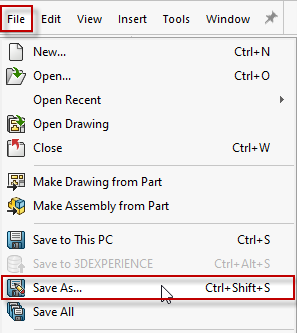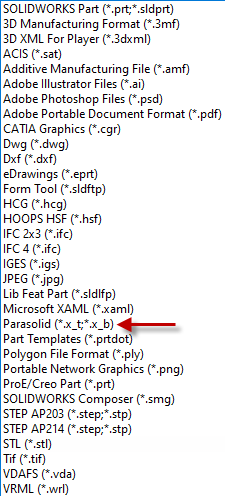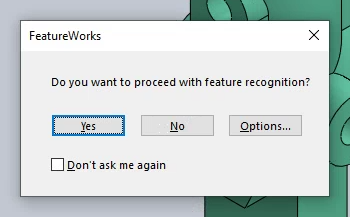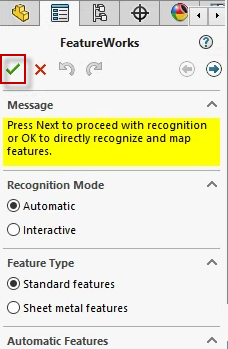How do I open SOLIDWORKS part files in older versions of SOLIDWORKS?
Universal File Types can be used to get around the lack of forward-compatibility in SOLIDWORKS, though this method may come with some costs. Here is a guide on how to do this, and what metadata you can expect to lose in the process.
SOLIDWORKS has been backward-compatible from the very beginning of its development. SOLIDWORKS 2023 can open files created in SOLIDWORKS 2022, 2021, even files created all the way back in the ‘90s if you happened to have one.
But the reverse is not generally true. SOLIDWORKS 2023 and older are not forward-compatable. SOLIDWORKS 2022 cannot open files made in SOLIDWORKS 2023, SOLIDWORKS 2018 can’t open anything made in Version 2019 or later, etc.
If you did open that file from the ‘90s in SOLIDWORKS 2023, make some changes, and save it, that file could never be opened in your copy of SOLIDWORKS 97 ever again. From that moment onward it would effectively be a 2023 version of the file and can never be opened by any version older than 2023 again.
It should be noted, however, that SOLIDWORKS 2024 and newer versions possess a Save as Previous Release feature. This allows you to save files as the previous two versions, provided you haven't used any features from said future versions in your design. For example, SOLIDWORKS 2024 can save files as SOLIDWORKS 2023 or 2022, so long as your model doesn't include a Symmetric Linear Patterned Feature. (Symmetric Linear Patterns were added in 2024.) However, this forward-compatibility is still somewhat limited in scope. If you don't have access to SOLIDWORKS 2024 or newer, or you are trying to move something back further than 2022, this article will still be of some assistance.
When I try to open a Version 2023 part in SOLIDWORKS 2021, it gives this error:

From this, it would be reasonable to conclude that it’s completely impossible. That if you made the mistake of saving the file in the wrong version, then the file is forever doomed, and you might as well just completely start over. That is, thankfully, not exactly the case. There is a way to open parts made in future versions of SOLIDWORKS, it just isn’t a good way.
But there are circumstances where that way becomes necessary, when an imperfect solution ends up being better than no solution at all. So, here is a guide for that imperfect solution.
(Note: this technique works specifically for SOLIDWORKS Part Files, ending in “.sldprt”. Assemblies, Drawings, and other kinds of files can likely be opened in past versions using a similar technique, but the scope of this article is for Parts alone. Additionally, this guide assumes you have access to both the future and past versions of SOLIDWORKS. Some steps may need to be adapted for your own personal circumstances if this is not the case.)
1) In Windows File Explorer, click on the View menu, hover over Show >, and ensure that File name extensions is Checked. Seeing the file name extensions will make it much easier to keep track of which file is which. In Step 3 you may also rename the new file before you save it, to distinguish between them.

2) In the Future version of SOLIDWORKS, open the part you wish to transfer and go to File > Save As:

3) Open the Save as Type drop-down menu:

4) Select the Universal File Type you will be using. I would recommend Parasolid (*.x_t) for a first pass. Then, Save the file.

5) Open the Universal File you created in the step 4 in the Past version of SOLIDWORKS. You will probably need to change the file extensions to All Files (*.*) to see the Universal File you’re trying to create.

When you are done with the Import Diagnostics, close out of it with the green Check Mark as you would any other SOLIDWORKS tool.


For most parts created in SOLIDWORKS, The FeatureManager Design Tree on the left side of the graphics area will tell you the order of operations used to create said part. All the Sketches, Features, Reference Geometry, etc. can be accessed there on the side in chronological order. That chronology does not get saved into any of the Universal File Types. In the transfer from Future versions of SOLIDWORKS to Past versions of SOLIDWORKS, there is no way at all to carry that data over. Instead, the part will open as a single, complex imported body in the FeatureManager Design Tree.

While that chronology data cannot be saved, Feature Recognition will take its best guess at how it was made and try to repeat that process. The program will, in essence, reverse engineer the imported body, attempting to give it a new chronology with as close to the original design intent as it can manage. The results are not perfect, and the resulting chronologies can sometimes be a bit wonky, but usually Feature Recognition is the only easy way to make changes an imported part at all.
When you choose to proceed with Feature Recognition, a FeatureWorks menu will open on the left. Generally, the settings are fine as they are, and you are OK to hit the green check mark.

8) Once you click the green check mark, several loading bars will appear in sequence, and the part will run through an animation of its reconstruction from the ground up. This process may take some time depending on the complexity of the part, and generally lose any appearances applied to them during this process. But once it finishes, you have a part quite like the original, though perhaps with a rather different design tree.

There are a few additional quirks and nuances to this process, of course. In fact, quite a few. Which Universal File Type you select can drastically change what information you are able to bring back to an older version. This article is to provide the process of this transfer alone. I have written another article detailing the nuances of each file type, and precisely what they do and do not store when they save.
But In this demonstration I used a model of an idler arm, attempting to transfer the file from SOLIDWORKS 2023 to SOLIDWORKS 2021. From my experiments, appearance was retained unless you used Feature Recognition, at which point it is lost. Applied materials were also lost in the transfer, as well as reference geometry and any sketches. Even when using a Parasolid, the best choice for this transfer process, you really don’t end up with very much besides the body itself.
